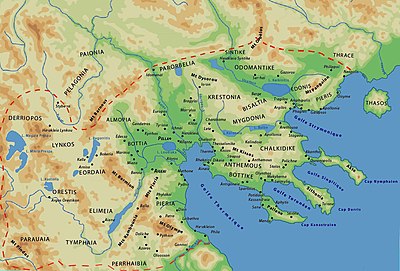Orestis (landscape)
Orestis ( Greek Ὀρεστίς ) referred to the mountainous landscape of Greece in ancient times , which rises on the upper reaches of the Aliakmonas river . It roughly comprised the land between the cities of Kastoria on Lake Kastoria in the north and Siatista in the south, located in what is now the regional districts of Kastoria and Kozani in the Western Macedonia region .
In ancient times, Orestis bordered on the west by the settlement area of Epirus , with the Boiongebirge as a natural border demarcation, the north and east of the landscapes Lynkestis and Eordaia , and on the south by the Elimiotis . With these three, including the Pelagonia landscape , Orestis represented one of the so-called upper mountain landscapes of Macedonia . Known ancient settlements were Keletron (probably identical to Kastoria) and Argos Orestikon .
According to Strabon's tradition , the country got its name from Orestes , who lived here for some time during his flight after the matricide and who also founded Argos Orestikon. Its inhabitants also emerged from the union of different Illyrian and Epirotian tribes , although he himself counted them to the Upper Macedonian tribes.
According to Appian , the ancient Macedonian royal house of the Argeads originally came from Argos Oresticon. Although this information is controversial in historical science, it is recognized as a reference to the origin of the Macedonians . Thucydides already knew to report that the original home of the Macedonians was to be found in the mountains of Elimiotis and Lynkestis, from where they expanded into the fertile Dutch areas on the Thermaic Gulf . Because Orestis was adjacent to both landscapes, it is likely that parts of the population also joined the expansion from there. While a kingdom formed in the new Lower Macedonian landscapes, which increasingly found connection with the Hellenic civilization, the mountain people of Orestis, like those of the other Upper Macedonian mountain regions, remained on a less civilized cultural level for a long time. It had its own princes, under whom it was able to maintain a loosely dependent or even independence from the Macedonian royal family until the 4th century BC. In particular, Antiochus is the only known prince of this landscape, who was called "king" by Thucydides.
When exactly the Orestis finally came under the direct rule of the Macedonian royal family is not known. Perhaps could already Perdiccas III. in the run-up to his Illyrian campaign in 359 BC Subjugate the region to the region, but no later than the reign of his brother Philip II , the landscape was completely integrated into the Macedonian state. The descendants of the Princely House were now sent to the royal court in Pella for training and education , where they were held hostage to vouch for the loyalty of their families and to be ideologically bound to the royal house themselves. 196 BC The Orestis became independent again when the Romans, after their victory in the Second Macedonian-Roman War over Philip V, declared the inhabitants of the region free because of their support for Rome in this war.
Personalities
- Prince Antiochus (5th century BC)
- Pausanias , bodyguard and murderer of Philip II.
- Perdiccas and his brother Alketas , both companions of Alexander the Great .
- Krateros and his brother Amphoteros , both companions of Alexander the Great
literature
- Fritz Geyer: Macedonia up to Philip II's accession to the throne. In: Historische Zeitschrift , Vol. 30 (1930), pp. 1–148.
- AB Bosworth: Philip II and Upper Macedonia , In: The Classical Quarterly , Vol. 21 (1971), pp. 93-105.
Individual evidence
- ↑ Strabo 7, 7, 8 and 9, 5, 11.
- ↑ Appian , Syriake 63. See Geyer, p. 47.
- ↑ Thucydides 2, 99, 2. According to Strabo (9, 5, 11) the Orestai were only later assimilated into the Macedonian tribal association.
- ↑ Thucydides 2, 80, 6.
- ↑ Diodorus 16, 93, 3.
- ^ Curtius Rufus 10, 7, 8; Arrian , Anabasis 6, 28, 4.
- ↑ Arrian ( Indike 18, 5) called Krateros coming from the Orestis.
